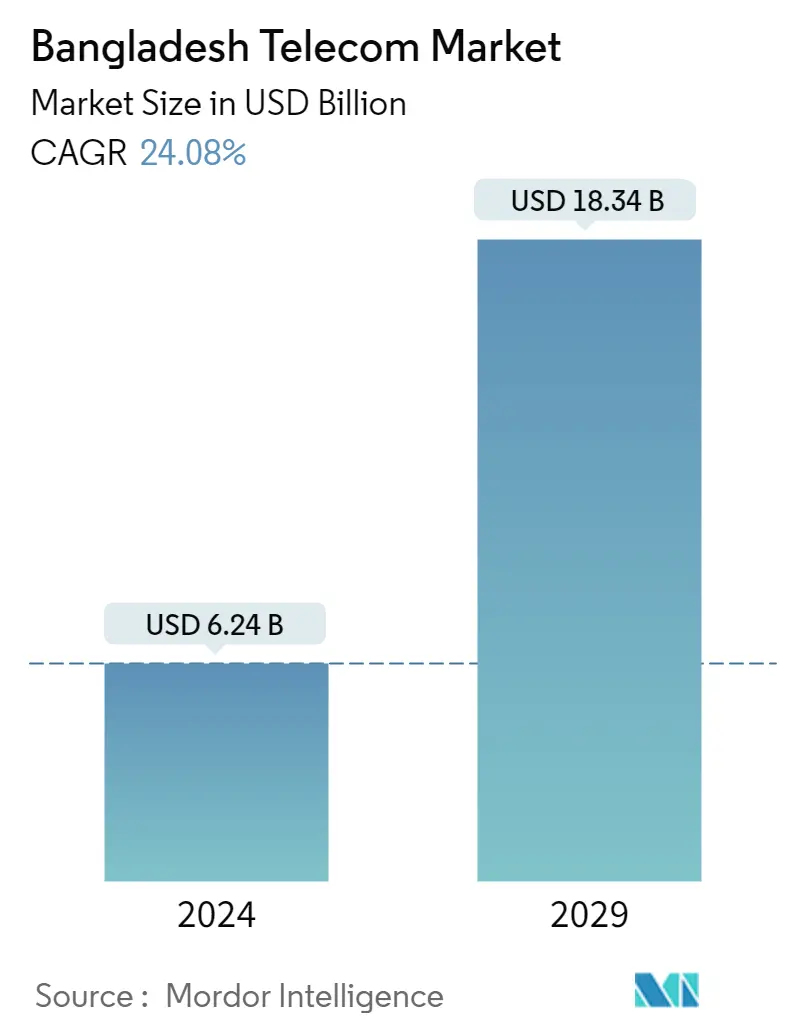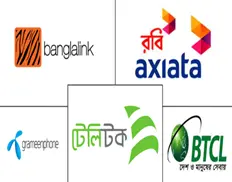Market Size of Bangladesh Telecom Industry

| Study Period | 2018 - 2028 |
| Base Year For Estimation | 2021 |
| Market Size (2023) | USD 5.03 Billion |
| Market Size (2028) | USD 14.78 Billion |
| CAGR (2023 - 2028) | 24.08 % |
| Market Concentration | Low |
Major Players
*Disclaimer: Major Players sorted in no particular order |
Need a report that reflects how COVID-19 has impacted this market and its growth?
Telecommunication in Bangladesh Market Analysis
The Bangladesh Telecom Market size is expected to grow from USD 5.03 billion in 2023 to USD 14.78 billion by 2028, at a CAGR of 24.08% during the forecast period (2023-2028).
While voice communication on mobile devices in Bangladesh has been crucial to the growth of the telecom industry, recent developments have seen a change in favor of digital inclusion. The key players in the industry include Banglalink Digital Communications Ltd, Robi Axiata Limited, Grameen Phone Ltd, Teletalk Bangladesh Limited DBA Teletalk, and Bangladesh Telecommunications Company Limited (BTCL).
- The number of mobile data customers in Bangladesh is increasing due to the variety of online activities and the growing popularity of mobile internet services. GSMA report predicts that Bangladesh's smartphone adoption rate will rise from 47% in 2021 to 63% by the end of 2025. According to the research titled "The Mobile Economy Asia Pacific 2022," Bangladesh's subscriber penetration rate will increase to 59% by the end of 2025 from 55% in 2021.
- As per a Financial Express report, The Ministry of Posts and Telecommunications in Bangladesh stated that rather than a blanket activation of the fifth-generation network, the country would implement the 5G network in stages and locations as needed. If Bangladesh connects to the third underwater cable, it is expected to receive 13,200 Gbps (gigabits per second) of capacity (S-MIM-UE-6).
- With the ambition of realization of "Vision 2041," Bangladesh is expanding quickly. Bangladesh's perspective plan aspires to elevate the nation to upper-middle-income level by 2031 and high-income status by 2041. The internet and digital technologies are anticipated to be the essential instruments for carrying out the strategy. Access to inexpensive and dependable connections is important to the government's goal of realizing its "Vision 2041," making digital inclusion a crucial part of this journey.
- The government's realistic choice to postpone the launch and rollout of 5G is noteworthy, given the low usage of 5G in Bangladesh. In the short to medium term, investing in 5G would not be profitable for the nation or the corporations involved. Even though there aren't enough business cases to support it, operators would nonetheless like to implement 5G just to gain from being early adopters and for competitive reasons. The necessity of 5G for Bangladesh to meet its 2041 objective cannot be disputed. The massive investment required, the state of the environment, and the currency reserve limits, however, considerably outweigh the intended advantages. Thus, it might not be considered immediately.
- Connectivity has become essential for the continuance of economic and social activity in Bangladesh after the COVID-19 pandemic. Telecommunication is essential in the country for enabling companies and educational institutions to continue to be active and offer people a way to socialize, work, and access a variety of life-improving services provided. Mobile service providers in Bangladesh have responded to the difficulties caused by the pandemic by taking steps to guarantee that mobile technology is used successfully to maintain a normal life.
